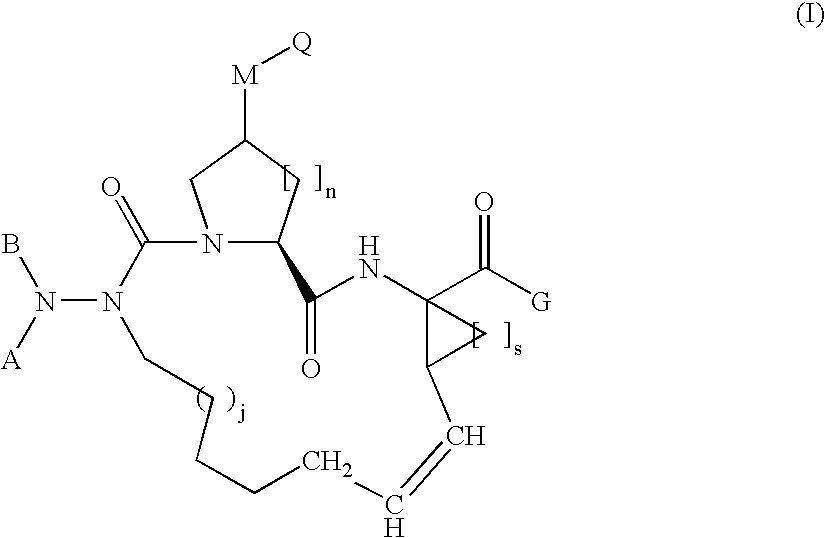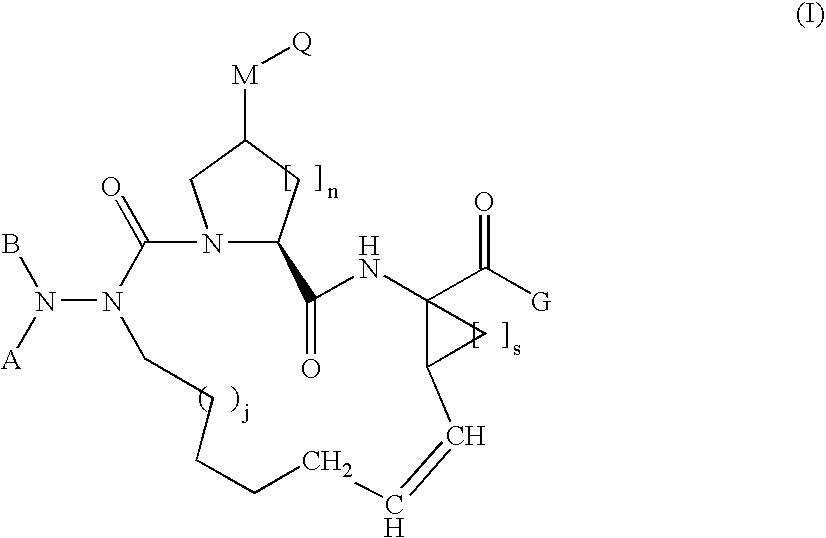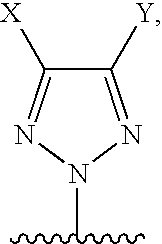Aza-peptide macrocyclic hepatitis C serine protease inhibitors
a technology of hepatitis c virus and macrocyclic hepatitis c serine protease, which is applied in the field of new drugs, can solve the problems of interferon related side effects, inability to reproduce infectious culture systems and small animal models for hcv, and increasing public health problems
- Summary
- Abstract
- Description
- Claims
- Application Information
AI Technical Summary
Benefits of technology
Problems solved by technology
Method used
Image
Examples
example 1
Compound of Formula (1-4), Wherein j=1
[0322]A solution of 8—Bromo-oct-1-ene (26.2 mmol), Boc-hydrazine (2 eq.), and tetrabutyl-amonium iodide (˜5 mg) in 10:1 ACN / DMSO is heated to 70° C. overnight. The mixture is then cooled and the excess solvent I removed in vacuo. The concentrated reaction mixture is then purified via silica gel column chromatography (15–20% EtOAc / Hexane) to yield a compound of formula (1-3), wherein j=1, as a clear oil. Triphosgene in DCM (5 ml) is added at 0° C. to a mixture of compound of formula (1-3) and DIEA (0.8 ml) in DCM (20 ml) and stirred 1.5 hours to yield the title compound in situ to be used in subsequent steps.
example 2
Compound of Formula I, Wherein A=Boc, B=hydrogen, G=OEt, M=—O—, Q=hydrogen, and j=n=s=1
Step 2a. Compound of formula (2-2), wherein A=Boc, B=hydrogen, T=OEt, and j=1.
[0323]The mixture of the title compound of Example 1 is added to a pre-stirred solution of cis-L-hydroxyproline ethyl ester hydrochloride and DIEA (1.2 ml) in DCM (10 ml). This mixture is then stirred overnight and then monitored for product formation via TLC. Once the reaction is deemed to be complete, the reaction mixture is then evaporated in vacuo to dryness and subsequently diluted in EtOAc. This mixture is then washed with water, NaHCO3, and brine before the organic phase is dried over anhydrous sodium sulfate. The dried organic phase is the concentrated in vacuo and subsequently purified via silica gel column chromatography, eluting with 30–40% EtOAc / Hexane to yield the title compound as a white powder.
Step 2b. Compound of formula (2-3), wherein A=Boc, B=hydrogen, T=OH, and j=1.
[0324]To a mixture of the compound ...
example 3
Compound of Formula I, Wherein A=Boc, B=hydrogen, G=OEt, M=—O—, Q=—S(O)2CH3, and j=n=s=1
[0327]To a solution of the macrocyclic peptide precursor of Example 2 and DIEA in DCM, mesylate chloride (0.1 ml) is added slowly at 0° C. where the reaction is kept for 3 h. The reaction mixture is then diluted with EtOAc, washed with 5% citric acid, water, 1M NaHCO3 and brine 2×10 ml, respectively. The organic phase is then dried over anhydrous Na2SO4 and concentrated in vacuo, yielding the title compound mesylate with no need to for further purification for use in subsequent steps.
PUM
| Property | Measurement | Unit |
|---|---|---|
| mol % | aaaaa | aaaaa |
| temperature | aaaaa | aaaaa |
| emission wavelength | aaaaa | aaaaa |
Abstract
Description
Claims
Application Information
 Login to View More
Login to View More - R&D
- Intellectual Property
- Life Sciences
- Materials
- Tech Scout
- Unparalleled Data Quality
- Higher Quality Content
- 60% Fewer Hallucinations
Browse by: Latest US Patents, China's latest patents, Technical Efficacy Thesaurus, Application Domain, Technology Topic, Popular Technical Reports.
© 2025 PatSnap. All rights reserved.Legal|Privacy policy|Modern Slavery Act Transparency Statement|Sitemap|About US| Contact US: help@patsnap.com



